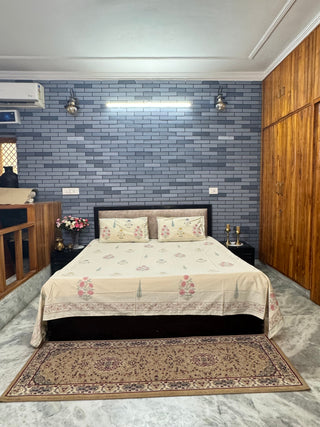A small village nearly 40 km from the main city of Jaipur (Rajasthan) lies a quaint small village which is keeping a 500 year old tradition alive of creating complex pieces of clothing. Juxtaposed to today’s commercialized scale of fast-fashion and one-time clothing the tradition of creating fabrics that are 100% naturally made is being sustained in a small village called Bagru.
A traditional Bagru print in created after intense labor and attention to detail. These prints are set apart from other form of textile creation based on the handworkes block-print designs and a traditional form of making natural dyes.
Mass produced clothes with prints are made using synthetic dyes which speed production times and reduce manufacturing costs by 10 times oveall. Depending on the intricacies of these prints handblock printing can be tedious. Typically a design will have 2-10 block which need to be applied in a specific configuration on a small patch, this process needs to be repeated over the entire clothing. Creating a single meter of final product can take a few hours to a few days. The added time for drying the fabric in-between block changes just makes the whole process more complicated. But these steps are common for most block-printing handicrafts.
What makes Bagru prints evermore special in the fact that each color is made 100% from natural source. The reds are made from pomogranade peels, blue from indigo, yellow from tumeric, green from leafs and vegetables. But to get one ounce of each color is a multistage process which requires hours of boiling, mixing, and concentration. This infact is the beauty of the whole art-form. Art is often considered as a futile endeavor for some, but the Bagru print objectively creates a product that is 100% sustainilby, eco-friendly, and is naturally made. It is true that everything comes from the earth but this is more true for bagru products. Earth and mud is important for step, the tempring of the cloths before and after each step is done using by dredging the garment in mud, which is a very interesting process. The garment truly comes from the earth.
What is mad that a small village tucked away in a remote corner in the arid desert state of India has nearly 80% population focused on just this one art from. Some people have graduated from the block printing to screen printing using these natural colors. But the uniqueness that block printing is unmatched.
To highlight the wonder of this concentration and influx (change word) of this printing technique in such a dry state can be further realised when one realises that cotton, jute etc (other plants) are not produced near or around this city, the raw-materials are soucrces and imported from 1000 of kms away (from other cities). These clothes are specailly sent here for specific printing. The reasons of this artform is confounding. But we believe that this is a reclic of the past similar to the Amer fort that still stands to this day.
Amer fort was created by one of the most prominent hindu kings called XYZ. He was the reason for why Jaipur prospered in the early days, his relics of 500 hundered years ago stand to this day interweaved with the today’s Jaipur. He was well known for promoting art and craft-work from around the country. On the main entraces to his palaces stays a painting which again was created with only using all natural dyes, these colors have faded since but not lost their brilliance and glory. This style of fresco paints might have been an inspiration to the Bagru colors and prints.
— Add about the kinds of prints/patters
— Add more details and video for each process of the paints
— Add images
We at Dalore want to bing you such lores within India, so that you can further integrate with our rich and diverse history and culuter. We want to take you all on this journey with us as we exlplore each region and all its marvelus. (vague make more concreate)
Again the reason of this concentration and influence of this handi-work in a dessert


